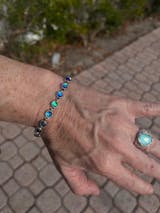Jewelry has traditionally been a means of personal expression, encapsulating the essence of one's beliefs, values, and tales in delicate, wearable art. Charm bracelets stand out from other types of jewelry due to its capacity to convey deep personal significance through small symbols. Religious charm bracelets, in particular, serve as powerful displays of faith, spirituality, and cultural history, in addition to being aesthetically pleasing. These charms not only adorn the wrist, but they also hold deep spiritual meaning, serving as daily reminders of one's values and convictions.
The practice of wearing sacred charms extends back to ancient cultures. Early Egyptians, for example, believed that amulets and charms had magical properties that could protect the wearer from evil spirits and offer good luck. These charms frequently featured gods, sacred creatures, and emblems of divine protection. Similarly, throughout the Middle Ages, Christian travelers carried sacred charms or relics as a symbol of their faith and devotion. Religious charms have evolved throughout time from basic protection tokens to elegantly designed pieces of jewelry that reflect the wearer's spiritual journey. Whether made of precious metals, wood, or other materials, these charms have always been a potent way to communicate with the holy.
Religious charms have many diverse forms, each with its own symbolism that symbolizes the beliefs and values of various faiths. The cross is one of the most well-known symbols in Christianity, representing Jesus Christ's crucifixion and subsequent resurrection. Cross charms are commonly worn as a symbol of faith, devotion, and a reminder of Christ's sacrifice for mankind. The Star of David, or Magen David, is a prominent symbol in Judaism that represents the connection between God and humanity, whereas the Hamsa charm, which is important in both Judaism and Islam, is thought to bring blessings, good fortune, and protection from the evil eye.
Similarly, the Om symbol in Hinduism, Buddhism, and Jainism reflects the essence of the universe and is commonly worn to encourage inner tranquility and spiritual awakening. The crescent moon and star are important symbols in Islam, representing faith and divine direction, whereas saint medals and charms in Catholicism indicate protection, guidance, and intercession. Other common symbols include the lotus flower in Buddhism and Hinduism, which represents purity and spiritual rebirth, and Taoism's Yin-Yang charm, which represents the universe's balance of opposites.
The materials used to make religious charm bracelets contribute significantly to their spiritual and aesthetic appeal. The most commonly utilized metals are sterling silver and gold, which give durability and timeless elegance. These metals also have metaphorical meanings: gold is frequently connected with divine light and purity, whilst silver represents reflection and the moon's calming force. Some religious charms have gemstones such as turquoise, amethyst, or sapphire, each of which is thought to have special spiritual characteristics. For example, amethyst is said to encourage peace and spiritual insight, whilst turquoise is thought to be a stone of protection and healing. The addition of enamel, wood, or semi-precious stones gives color and dimension to these charms, increasing their visual appeal and spiritual meaning.
Craftsmanship is essential for crafting religious charms that are both attractive and meaningful. Artisans frequently use techniques including as engraving, embossing, and filigree to add complex features that highlight the symbolism of each charm. Whether it's a tiny cross charm with complex scrollwork or a Hamsa charm with detailed designs, the craftsmanship guarantees that each piece is a work of art that speaks to the wearer.
While religious charms have a long history, they have recently gained popularity in current design. Today's jewelry designers combine classic symbols with contemporary designs, allowing for a wider selection of styles to suit different tastes. Whether you like a simple bracelet with a single symbolic charm or a more ornate one embellished with several symbols, there is a style to suit you. Religious charms have also grown in popularity as a result of the desire toward personalized jewelry. Many people now prefer to make personalized charm bracelets that mix religious symbols with other significant charms like initials, birthstones, or inspiring quotations. This customization enables wearers to design a one-of-a-kind piece of jewelry that communicates their spiritual story and expresses their personal faith experience.
Religious charm bracelets are highly adaptable and can be worn in a variety of ways. For a modest effect, wear a single charm on a thin chain bracelet or a leather cord. This style is suitable for everyday wear and lends a sense of spirituality to any outfit. If you like a more statement-making appearance, put many charm bracelets together or select a bracelet with several religious symbols that speak to you. Combining different metals, textures, and symbols can result in a distinctive, eclectic look that expresses your spiritual beliefs and personal fashion sense.
Religious charm bracelets are more than just stunning pieces of jewelry; they are profound representations of faith, culture, and personal convictions. By wearing these charms, people can carry their spiritual journey with them, finding comfort, protection, and inspiration in the symbols they pick. Religious charm bracelets, whether passed down through generations as cherished heirlooms or purchased new as a personal statement of faith, are timeless pieces of jewelry that transcend fashion trends and connect us to something higher than ourselves.





